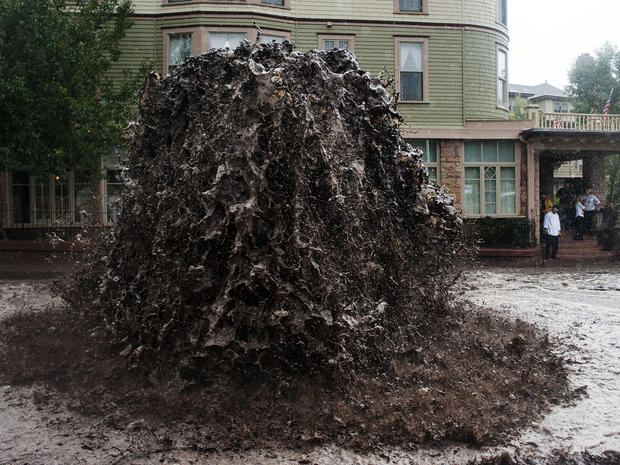Death toll rises from Colorado flooding
LYONS, Colo.Colorado officials have raised the death toll from this week's flooding to four after a woman's body was found in Boulder.
Boulder County Sheriff Joe Pelle says the body found Friday was that of a woman who was swept away Thursday after the vehicle she was riding in got stuck in water north of Boulder.
She was not identified.
A man in the same vehicle died after he got out trying to help her.
A third person died Thursday when a structure in Jamestown collapsed. To the south, Colorado Springs officers found a man's body in Fountain Creek.
CBS Denver reports that 172 people in Boulder County are still unaccounted for. Earlier, Pelle said that people who were unaccounted for weren't necessarily missing.
With rain still falling and the flood threat still real, authorities called on thousands more people in the inundated city of Boulder and nearby towns to evacuate as rivers and creeks rose to dangerous levels.
The late-night reports from Boulder and the village of Eldorado Springs came as rescuers struggled to reach dozens of people cut off by flooding in Colorado mountain communities. Residents in the Denver area and other downstream communities were warned to stay off flooded streets.
"This water is filled with debris and sand," Colorado Gov. John Hickenlooper said during a Friday morning news conference. "It's almost like liquid cement."
The towns of Lyons, Jamestown and others in the Rocky Mountain foothills have been isolated by flooding and without power or telephone since rain hanging over the region all week intensified late Wednesday and early Thursday.
At least three people were killed and another was missing, and numerous people were forced to seek shelter up and down Colorado's populated Front Range.
Two backpackers who became stranded while hiking the 14,259-foot Longs Peak were able to hike to safety, the National Park Service said Friday.
Suzanne Turell and Connie Yang of York, Maine, had sent a text message at 9 a.m. Thursday with their GPS coordinates, but their cellphones later went dead, said one of their mothers, Barbara Turell of Federick, Md.
They had a tent but did not have cold-weather gear, she said
On Thursday, a bridge that disappeared sent three vehicles into the water, CBS News correspondent Barry Petersen reported from Boulder on "CBS This Morning" Friday. Just as rescuers were about to save one driver, the water pushed the car even deeper. In the end, the motorist was one lucky man.
Late Thursday, warning sirens blared in Boulder and city officials sent notice to about 4,000 people living along Boulder Creek around the mouth of Boulder Canyon to head for higher ground, according to Boulder's Daily Camera newspaper.
The alert was prompted by rapidly rising creek levels caused by water backing up at the mouth of the canyon because of debris and mud coming off the mountainsides, the city Office of Emergency Management said.
The creek began to recede after midnight, but the conditions remained dangerous and a surprising amount of water was still flowing into the city's streets, Police Chief Mark Beckner told the Daily Camera after touring the damage.
Nick Grossman, of the Boulder Office of Emergency Management, told CBS News early Friday that Emerson Gulch, west of Boulder, washed out due to heavy rain, saturated soil and tumbling debris. The gushing water was filling Boulder Creek, which heads into downtown. That was likely to cause more flooding.
CBS Denver warned that flash flooding was still possible through the weekend and a reprieve was likely on Monday and Tuesday with clearing conditions and temperatures closer to normal.
The entire hamlet of Eldorado Springs, about 500 people, was urged to evacuate because of a flash flood and mudslide threat along South Boulder Creek, Boulder County spokesman James Burrus said.
Northwest of Boulder, the overflowing Vrain Creek cut the town of Longmont in half. Evacuation requests were issued for some neighborhoods, all major roads were closed, and several thousand homes and businesses were without power, he said.
Interstate 25 east of Loveland was closed in both directions Friday, state transportation officials said.
In Fort Collins, neighborhoods along the Cache La Poudre River were evacuated overnight, with the river expected to rise to nearly 2 feet above flood stage Friday morning, according to the National Weather Service.
City officials in Fort Collins closed bridges after water began topping Seaman Reservoir in the Poudre Canyon, The Denver Post reported. The city warned residents to stay clear of the river.
South of the historic Red Rocks Amphitheater, Jefferson County deputy sheriffs went door-to-door in Morrison and Kittridge, asking hundreds of residents to leave their homes as Bear Creek neared flood stage. The amphitheater was in no immediate danger.
In Lyons, residents took shelter on higher ground, including some at an elementary school. Although everyone was believed to be safe, the deluge was expected to continue into Friday.
"There's no way out of town. There's no way into town. So, basically, now we're just on an island," said Jason Stillman, 37, who was forced with his fiancee to evacuate their home in Lyons after a nearby river began to overflow into the street.
The Colorado National Guard began trucking people out of Lyons on Thursday evening.
To the north, residents along the Big Thompson Canyon in Larimer County, scene of the deadliest flash flood in state history, were also evacuated. The Big Thompson River flooded in 1976 after about a foot of rain fell in just four hours, killing 144 people.
Early Friday, the National Weather Service warned of more flash flooding in Loveland, according to the Post. NOAA reported that the Big Thompson River at Drake was more than 4 feet above its flood stage of 6 feet.
President Obama signed an emergency declaration Thursday night, freeing federal aid and allowing the Federal Emergency Management Agency to coordinate disaster relief efforts.


